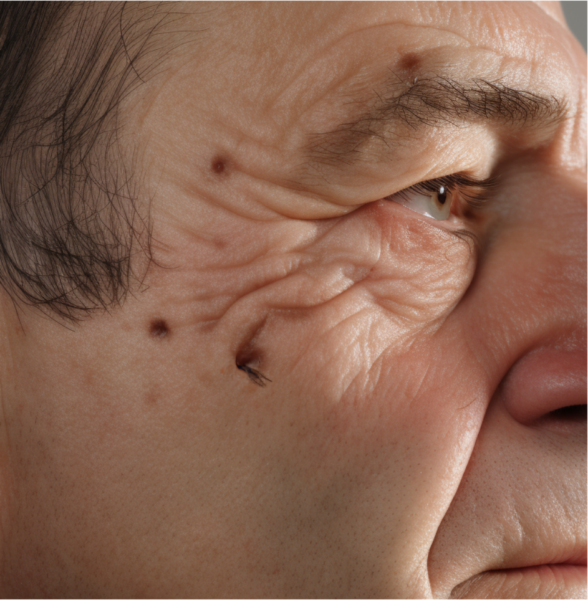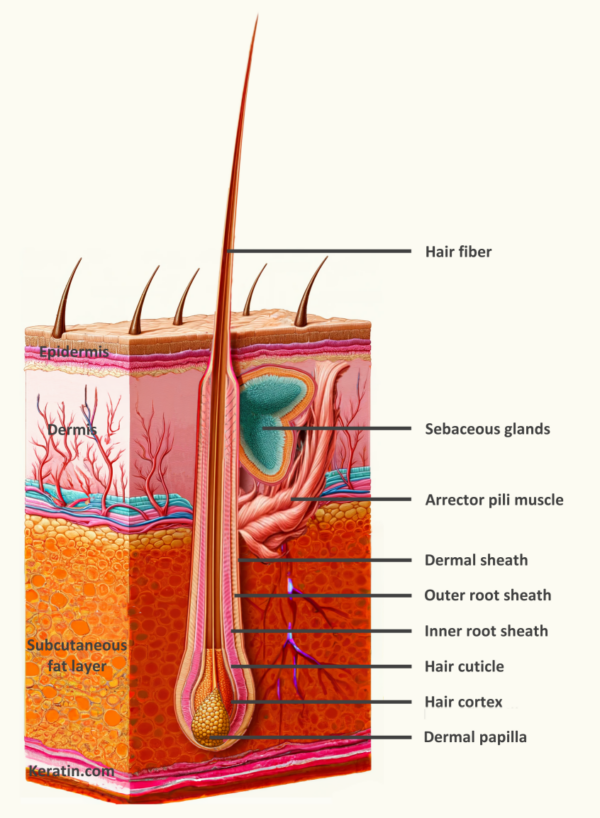Despite their dissimilarities, hair and fish scales – both integral vertebrate appendages – share a striking correlation in their evolutionary journey. At the core of this connection lies an intricate weave of genetic pathways and regulatory mechanisms vital for their formation and development.
Both fish scales and hair follicles play crucial roles as components of the integument skin system, setting up a boundary between an organism and its environment and contributing to the internal state of balance among all the body systems (a process called homeostasis). Fish scales predominantly serve a protective function. They form a hard, defensive layer that shields the fish from potential external threats and injuries. They also contribute to the fish’s locomotion through water, as the various shapes and arrangements of scales affect the fluid dynamics surrounding the fish. This allows fish to move more efficiently and adapt to diverse aquatic environments. The scales can also reflect light in specific patterns, which can be used for communication with other members of the same species, for instance, during mating displays.

Hair follicles in mammals, including humans, serve a variety of purposes that are also essential for survival, though somewhat different from those served by fish scales. One primary function is thermal regulation; hair follicles aid in maintaining an organism’s body temperature by providing insulation. They also serve a sensory function, as hair follicles are connected to nerve fibers, enabling the organism to sense changes in the environment such as touch or wind direction. Similar to fish scales, hair also plays a role in communication. In many animals, hair patterns, colors, and displays can signal various messages such as dominance, reproductive readiness, or threats to other animals. Thus, while both fish scales and hair follicles serve as protective elements and communicative platforms in their respective organisms, they do so in remarkably different ways, reflecting the diversity and specificity of evolutionary adaptations.
Skin appendages, like hair, teeth, and scales, have proven to be significant models for examining developmental patterns and their evolutionary significance. While these structures vary greatly across species, recent studies suggest they all developed during evolution from a common progenitor structure in stem amniotes (tetrapod vertebrates including reptiles, birds, and mammals) somewhere back in ancient evolutionary history.
A historical narrative of this evolutionary link can be traced back to Charles Darwin, who, in 1875, shed light on the ‘toothless men of Sind,’ suffering from hypohydrotic ectodermal dysplasia; a genetic condition leading to abnormality or absence of teeth, body hair, and mucous glands. Studies into the human genome have pinpointed a mutated gene responsible for this condition. This gene, found to encode a cell transmembrane protein, called ectodysplasin or “EDA”, was later identified to bear similarities to tumour necrosis factor (TNF) family members.
The plot thickened with the discovery of the spontaneous mouse genetic mutant “Tabby”, which revealed tooth defects and developed only a single type of hair (mice normally have five different types of hair with differences in size and structure). The Tabby gene was identified as homologous to human EDA. Furthermore “Downless”, another spontaneous mouse mutant with an identical phenotype to Tabby, encoded a TNF-like receptor, called EDAR, that interacts with EDA. These various gene mutations in EDA and its receptor EDAR highlighted the crucial role of EDA-EDAR interactions in tooth and hair follicle development.
To delve into the mysteries of fish scales and their relationship to hair follicles, we turn to teleosts, marine creatures covered with elasmoid scales — appendages formed from fish dermal mesenchyme. A mutation in the teleost Medaka (also known as the Japanese rice fish), namely rs-3, results in a failure of most scale development on the fishes’ skin. Intriguingly, the rs-3 locus was later found to encode EDAR, thereby cementing the connection between mammalian hair loss and fish scale development through the same TNF family signalling pathway. Notably, hair and fish scales differ in their basic structure and constituent features, with fish scales being mineralised dermal elements devoid of keratin. In contrast, hair is not mineralized rather, keratin proteins provide its strength.
Yet, even with these distinctions in mind, it is clear that the EDA/EDAR TNF signalling pathway is integral in the development of both fish scales and hair follicles. The common developmental mechanism for scale and hair appendage formation involves epidermal-dermal interactions. However, this similarity doesn’t indicate a direct evolutionary link, but rather a shared usage of a genetic pathway in the formation of functionally similar, but morphologically unrelated organs.
Substantial evolutionary ties also exist between fish scales and teeth. Dermal armour from ancient vertebrates is the believed precursor of scales in teleost fish. Parallel structural and developmental aspects between fish dermal armour and mammalian teeth bolster the idea of teeth having evolved by internalisation of dentin-containing dermal armour into the oral cavity. EDA/EDAR TNF signalling’s role in both scale and tooth development aligns with this evolutionary hypothesis.
It’s not just EDA/EDAR TNF signalling that is important in both fish scale and hair follicle development. Fish scales have been the subject of various histological and genetic studies. Studies have shown a series of signalling pathways, including Wnt/β-catenin, Eda, Fgf, and Shh, have all been discovered to regulate scale patterning and morphogenesis. These same signalling pathways are important for hair follicle and for tooth development, thus hinting at multiple shared genetic pathways.
The narrative of hair and fish scale evolution presents a complex interplay of genetic pathways and cellular interactions. Their development relies on similar molecular mechanisms, pointing to a common structural appendage ancestor despite the morphological differences seen in fish and mammals today. Further, it underscores the significance of shared genetic pathways in the development of diverse skin appendages. The intricate developmental narrative of hair and fish scales not only enriches our understanding of vertebrate evolution but also paves the way for further research into the cellular mechanisms underpinning the evolution of genetic regulatory processes.
Bibliography


